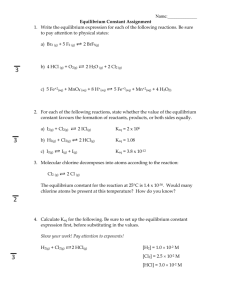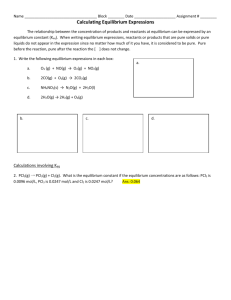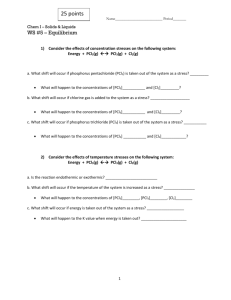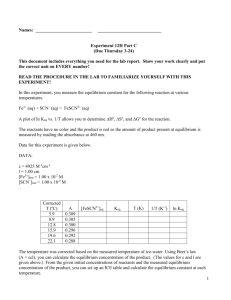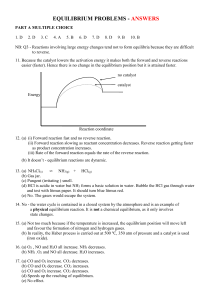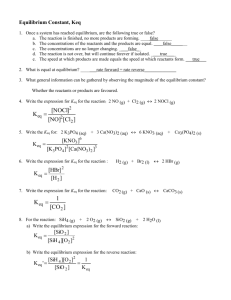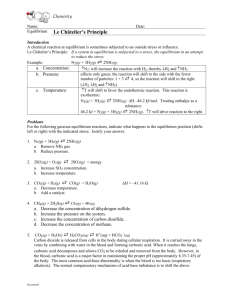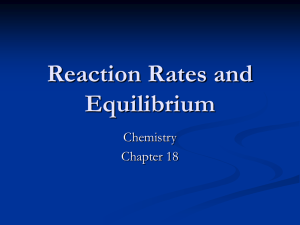CP Chapter 18 Notes A Model for Reaction Rates Expressing
advertisement
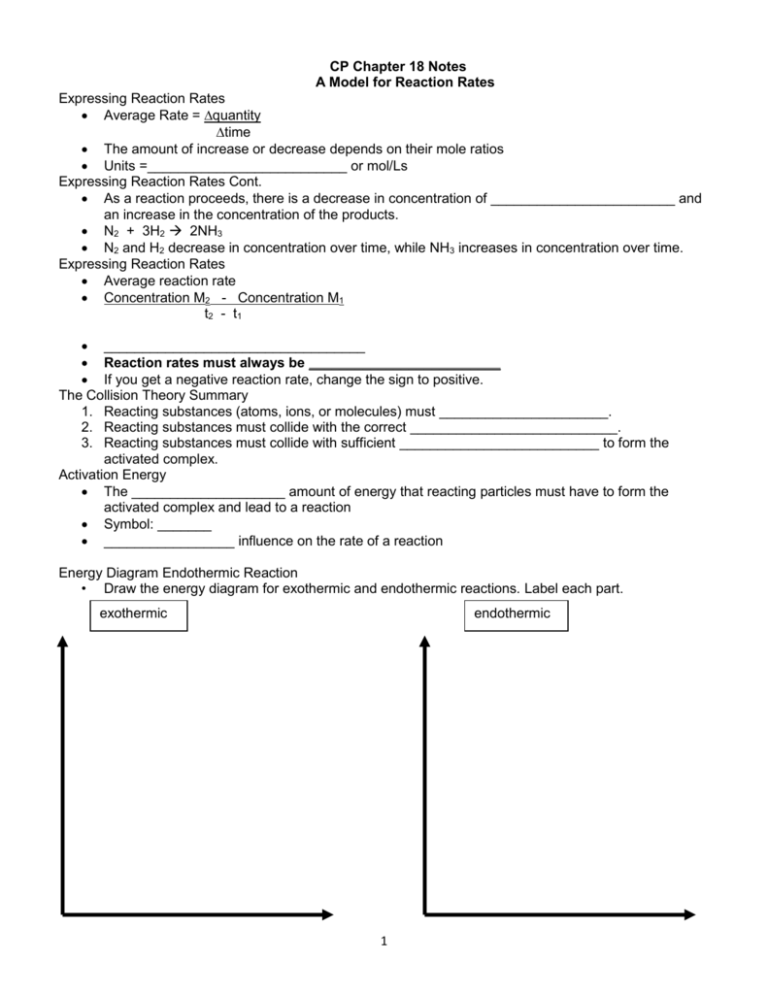
CP Chapter 18 Notes A Model for Reaction Rates Expressing Reaction Rates Average Rate = quantity time The amount of increase or decrease depends on their mole ratios Units =__________________________ or mol/Ls Expressing Reaction Rates Cont. As a reaction proceeds, there is a decrease in concentration of ________________________ and an increase in the concentration of the products. N2 + 3H2 2NH3 N2 and H2 decrease in concentration over time, while NH3 increases in concentration over time. Expressing Reaction Rates Average reaction rate Concentration M2 - Concentration M1 t2 - t1 __________________________________ Reaction rates must always be _________________________ If you get a negative reaction rate, change the sign to positive. The Collision Theory Summary 1. Reacting substances (atoms, ions, or molecules) must ______________________. 2. Reacting substances must collide with the correct ___________________________. 3. Reacting substances must collide with sufficient __________________________ to form the activated complex. Activation Energy The ____________________ amount of energy that reacting particles must have to form the activated complex and lead to a reaction Symbol: _______ _________________ influence on the rate of a reaction Energy Diagram Endothermic Reaction • Draw the energy diagram for exothermic and endothermic reactions. Label each part. exothermic endothermic 1 Calculating Average Reaction Rates Given H2 + Cl2 2HCl Time (s) [H2] (M) [Cl2] (M) [HCl] (M) 0.00 0.060 0.070 0.00 5.00 0.025 0.035 0.035 Calculate the average reaction rate expressed in moles H2 consumed per liter per second. Calculate the average reaction rate expressed in moles Cl2 consumed per liter per second. Reaction Rates An expression that relates rate of reaction and ________________ concentration Rate of reaction __________________ on reactant concentrations Never includes _____________________ Given: 2A + 3B → 2C o In general, rate = k [A]X [B]Y Rate Constant • Symbol: ______ • A constant specific and ______________ for every reaction • If k is large, products form _______________ • If k is small, products form slowly _______________ Order of reaction • _________________ in rate law (x and y) • Determine how much the rate depends on the respective concentration(s) • Can ONLY be determined by __________________ • Overall order of a reaction is the sum of all orders (x + y) Example 1: 2A + 3B → 2C • Skeleton rate: ____________________ • Overall order of reaction (x + y) o If x=1, _______________ o If x=2. _______________ o Overall order _____ + _____ = _____ Example 2 Write the skeleton rate law for 2H2O(l) → 2H2(g) + O2(g) 2 Relationship of order and rate • Example 1: rate = k [A] _____________ o If concentration of A doubles, rate _______________ o If concentration of A triples, rate________________ o If concentration of A is halved, rate _____________ • Example 2: rate = k [A]2 ______________ o If concentration of A doubles, rate _______________ o If concentration of A triples, rate is ____ times as fast • Example 3: rate = k [A]0 ______________ o Recall: anything raised to the 0th power = ______ o If the concentration of A changes in any way _______________ happens to the rate o Rate is not dependent on concentration o Rate = k Factors Affecting Reaction Rates Factors Affecting Reaction Rates There are several factors affect reaction rates o Concentration o ________________ ___________ (Particle size) o Temperature o Catalysts o Inhibitors Catalysts A catalyst is a substance that ________________________ the rate of a chemical reaction _____________________ itself being used up in the reaction. A catalysts provide an alternative energy pathway for the reaction. The different pathway _____________________________ the activation energy allowing more molecules to overcome the activation energy and produce products at a faster rate ΔH Inhibitor An inhibitor is a substance that __________________________ down, or inhibits reaction rates. Uses o A preservative o A weed killer 3 Equilibrium: A State of Dynamic Balance Reversible Reactions When a reaction results in complete conversion of reactants to products chemists say it goes to ____________________________. Not all reactions go to completion. They appear to stop because they are _________________________. Reversible reactions can occur in both the ____________________ and _________________________ direction. Reversible Reactions cont. . . N2 + 3H2 ⇆ 2NH3 o In the forward reaction, the reactants are ________________ and __________ ; the product is NH3 o In the reverse reaction, the reactant is __________; the products are N2 + 3H2 o The forward and reverse reactions are happening at the same time. Chemical Equilibrium Chemical equilibrium is a state in which the forward and reverse reactions balance each other because they take place at equal __________________. o Rateforward reaction = Ratereverse reaction This does not mean the concentrations of the products and reactants are the ___________________ Equilibrium is a state of action, not inaction. This process is dynamic; dynamic equilibrium. http://www.youtube.com/watch?v=JsoawKguU6A Equilibrium Expression and Constant (Keq) Law of chemical equilibrium states that at a given ________________________, a chemical system may reach a state in which a particular ratio of reactant and product concentrations has a ________________________ value known as Keq or equilibrium constant. Equilibrium Constant Keq Keq is the ratio of ______________________________ concentrations to __________________ concentrations. Keq only includes compounds that are in the _______________ or aqueous state, not solid or liquid A _____________________ Keq, Keq > 1 means the products are _______________________ over the reactants A _____________________ Keq, Keq < 1 means the reactants are favored over the ______________________. Homogenous vs. Heterogeneous Equilibrium Homogenous equilibrium means all reactants and products are in the _________________ physical state Ex: H2(g) + O2(g) H20(g) Heterogeneous equilibrium is when the reactants and products are in _______________ than one physical state. Ex: H2O(g) + C(s) H2(g) + CO(g) Chemical Equilibrium - Keq 4 Homogenous Equilibria Given N2(g) + 3H2(g) ⇄ 2NH3(g). Write the equilibrium constant expression for the reaction. Given 2SO2 (g) + O2 (g) ⇄ 2SO3 (g). Write the equilibrium constant expression for the reaction. Heterogeneous Equilibria Given 2NaHCO3(s) ⇄ Na2CO3(s) + CO2(g) + H2O(g). Write the equilibrium constant expression. Calculating the Value of Equilibrium Constants At equilibrium and 100oC a flask contains: [ PCl5] = 0.0325 M [H2O ] = 0.0250 M [HCl] = 0.375 M Calculate the Keq for the reaction PCl5 (g) + H2O (g) ⇄ 2HCl (g) + POCl3 (g). 5 [POCl3] = 0.250 M Day 1: Le Chatelier’s Principle – Concentration & Temperature Day 1: Le Chatelier’s Principle If a stress is applied to a system at equilibrium, the system shifts in the direction that ___________________ the stress. Stresses include: o Change in _________________________ o Change in volume/pressure o Change in __________________________ Le Chatelier Change in Concentration Stress PCl5(g) [PCl5] [Cl2] [Cl2] PRACTICE [PCl5] [PCl3] [PCl3] TEMPERATURE temperature heat PCl5(g) ⇆ PCl3(g) + Cl2(g) ΔH = -47 kJ ⇆ PCl3(g) Cl2(g) Day 2: Le Chatelier’s Principle − Volume/Pressure Volume and pressure are related. As the volume goes up the pressure goes _________________ and vice versa. (Boyles Law; P1V1=P2V2) REVIEW FROM CH.14 Only _____________ are affected by a change in volume/pressure You need to count the number of ___________ of gas on each side of the reaction. 2H2O (g) 2 H2(g) + O2(g) The left side has 2 molecules of gas, while the right side has 3 molecules of gas If the stress is pressure ___________________, shift toward the side with the least number of moles of gas. If the stress is pressure decreasing, shift toward the side with the ____________ number of moles of gas. Le Chatelier and Pressure - YouTube Change in Volume/Pressure PCl5(g) ⇆ PCl3(g) + Cl2(g) Stress PCl5(g) ⇆ PCl3(g) Cl2(g) pressure volume pressure volume PRACTICE CO(g) + 3H2 (g) CH4(g) + H2O(g) Stress CO(g) H2 (g) ⇆ CH4(g) pressure volume N2O4(g) ⇆ 2NO2(g) Stress N2O4(g) ⇆ 2NO pressure volume 6 H2O(g)

